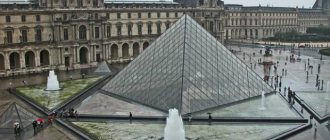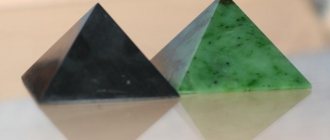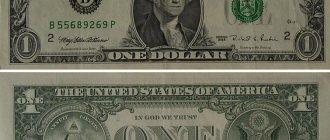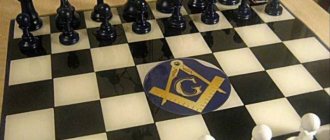- 1 bottle of perfume. Fragrances are often released in glass pyramid bottles. ...
- 2 paperweights. Paperweights are decorative objects made of glass, ceramics and hard plastic. ...
- 3 cafes Umbrellas. Some cafe table umbrellas have a pyramidal shape. ...
- 4 New Year's decorations. ...
- 5 cheeses.
Likewise, what are examples of prisms? Prism examples
- Corrugated box. Corrugated boxes are usually made in the shape of a cube or rectangular parallelepiped. ...
- Books and notebooks. Books and notepads are another example of prism-shaped objects present around us. ...
- Rubik's Cube. ...
- Ice cubes. ...
- Tents. ...
- Chocolate bar. ...
- Building. ...
- Watch.
What kind of pyramid could it be? Each base edge and vertex form a triangle called a side face. It is a conical body with a polygonal base. A pyramid with an n-sided base has n+1 vertices, n+1 faces and 2n edges. All pyramids are self-dual. ... Pyramid (geometry)
| Right-handed pyramids with a regular base | |
| Shlyafli symbol | ( ) ∨ {n} |
| Liki | n triangles, 1 n-gon |
| Ribs | 2n |
| peaks | n+1 |
How to draw a pyramid for children?
Related pages:Blog
What is the meaning of 2 root 2?
What is the area of the plot?
How do you perform operations on absolute values?
What fraction is 7/8?
Secondly, What is a pyramid with a triangular base? A triangular pyramid is a pyramid that has a triangular base. Tea tetrahedron
is a triangular pyramid with equilateral equilateral triangles on each face. ... A regular tetrahedron is a special case of a triangular pyramid.
Pyramid elements
The elements of this geometric figure are:
- The place where all the side faces of the figure meet is the vertex.
- A polygon with triangular edges extending from each side is called a base. For example, it can be hexagonal.
- Triangles that connect at the top, with a common side with the base, are called lateral faces. Their opposite vertex coincides with the apex point of the pyramid.
- The height of the figure is a vertical segment bounded by the base polygon and the top.
- An apothem can be indicated on each side triangle. It descends from the top along the edge to the edge of the base, being perpendicular to it.
- Side edges are those segments that connect adjacent side faces.
- A pyramid can have several diagonal sections. They include the diagonal of the polygon along with the vertex of the pyramid.
Truncated pyramid Let's study in this lesson what kind of pyramid is called a truncated pyramid and how to get it from a regular pyramid. Let's see what parts a truncated pyramid consists of, and also give the definition of a regular truncated pyramid.
So, in the phrase truncated pyramid, the word truncated itself suggests that the pyramid was taken and somehow truncated. Indeed, to obtain a truncated pyramid, it is enough to draw a section of the pyramid parallel to the plane of the base. Look what happens if we draw a section in the pyramid PA1A2...An parallel to the plane of the base A1A2...An, intersecting the side edges at points B1, B2, ..., Bn. We see in the figure two convex polyhedra:
One of which is a pyramid similar to our initial pyramid, but the second polyhedron will be called a truncated pyramid. Let us consider in more detail what parts this figure consists of (Fig. 3).
These components will be two n-gons A1A2...An and B1B2...Bn, we will call them the bases of the truncated pyramid and we will call their n quadrilaterals the side faces. We are ready to define a truncated pyramid. A polyhedron whose faces are n-gons A1A2...An and B1B2...Bn (lower and upper bases), located in parallel planes, and n quadrangles A1A2B2B1, A2A3B3B2,..., AnA1B1Bn (side faces), is called a truncated pyramid.
After we have given the concept of a truncated pyramid, let’s try to find in our life something similar to a truncated pyramid. Let's consider just some objects that have the shape of a truncated pyramid. An example of a truncated pyramid would be a street lamp or a hood over the hob of a kitchen stove; we can also say that a keyboard button is also a truncated pyramid. And even a delicious holiday cake can have the shape of a truncated pyramid.
To solve problems and prove statements, those elements of a truncated pyramid that we mentioned earlier are not enough, so let’s add to our knowledge base and give a few more definitions regarding a truncated pyramid. The segments A1B1, A2B2, ... are called the lateral edges of the truncated pyramid. A perpendicular drawn from any point of one base to the plane of another base is called the height of a truncated pyramid. In the figure, CH is the height of the truncated pyramid A1A2...AnB1B2...Bn.
Each of the side faces of the truncated pyramid will be a trapezoid and this can be proven. Let's look at the side face A1A2B2B1. The sides A1A2 and B1B2 are parallel, since they belong to the straight lines along which the plane PA1A2 intersects with the parallel planes α [alpha] and β [beta]. The other two sides A1B1 and A2B2 of this face are not parallel - their extensions intersect at point P.
A quadrilateral in which two sides are parallel and the other two are not is called a trapezoid, which means that the side faces of a truncated pyramid are trapezoids.
When we looked at the pyramid, we singled out the correct pyramid from the many pyramids. Among the truncated pyramids, regular truncated pyramids can also be distinguished. A truncated pyramid is called regular if it is obtained by cutting a regular pyramid with a plane parallel to the base. The bases of a regular truncated pyramid are regular polygons, and the side faces are isosceles trapezoids. The heights of these trapezoids are called apothems. The lateral surface area of a truncated pyramid is the sum of the areas of its lateral faces. We know that in mathematics, and even more so in geometry, any statement requires proof if it is not an axiom. It is the proof of these statements that we will deal with in the next lesson.
I would like to note that not a single geometric figure is studied for the sake of the figure itself. Everything in mathematics is studied for practical purposes. And many examples were given where in life you can find a truncated pyramid. By the way, you need to know the parameters of a street lamp in order to choose the right light bulb that will be used for lighting. When baking a delicious cake in a large or small pan, you need to know how much to prepare for the biscuit. And in general, based on the size of the cupcake, will it be enough for our guests?
Results:
A truncated pyramid is a polyhedron whose faces are n-gons A1A2...An and B1B2...Bn (lower and upper bases), located in parallel planes, and n quadrangles A1A2B2B1, A2A3B3B2,..., AnA1B1Bn (side faces).
The side face of a truncated pyramid is a trapezoid, because a quadrilateral in which two sides are parallel and the other two are not is called a trapezoid.
A truncated pyramid is called regular if it is obtained by cutting a regular pyramid with a plane parallel to the base.
The bases of a regular truncated pyramid are regular polygons, and the side faces are isosceles trapezoids. The heights of these trapezoids are called apothems
Types of pyramids
Such figures can be of different types, depending on the type of base and the location of the top.
The following types of pyramids can be specified:
- Correct
it will be if the base is a regular polygon. The projection of the vertex onto the base polygon must be at the center. The tetrahedron is considered as one of the varieties of a regular pyramid.
- U rectangular
of the figure, one of the faces is in a plane perpendicular to the polygon lying at the base.
- Truncated
- this is the part of the figure located between the intersecting plane and the base polygon. Moreover, this plane should be located horizontally.
What is an example of a rectangular prism?
Rectangular prisms or cuboids surround us everywhere. Here are some examples. books, boxes, buildings, bricks, boards, doors, containers, cabinets, mobile phones and laptops
. Non-examples of a right-handed rectangular prism: This shape is a prism, but its top and base do not have right angles in the shape.
then what is the real example of a rectangular prism? Rectangular prisms: boxes and tanks
Here are some examples from everyday life: rectangular tissue boxes, juice boxes, laptop computers
, school notebooks and folders, standard birthday gifts such as shirt boxes, cereal boxes and fish tanks.
Is the cube a prism or a pyramid? Prisms and pyramids in elementary school
| 3D shape | Prism or pyramid? | Ribs |
| Cubo | Prism | 12 |
| Triangular prism | Prism | 9 |
| Square pyramid | Pyramid | 8 |
| Pyramid with a triangular base | Pyramid | 6 |
Properties of the pyramid
This volumetric geometric figure has the following properties, provided that the side edges are equal:
- a circle can be described around a base polygon;
- the angle at which the side faces are inclined will be the same.
In the case where triangular faces have the same angles with the base, it is possible to conclude that their edges are the same.
How to activate the magical properties of a talisman
Having created and correctly placed the amulet, you need to begin activating it.
This ritual must continue continuously for 9 days. Throughout the entire period from dawn to 12 noon, you need to approach your talisman and imagine how your cherished dream comes true. Imagine in the smallest detail everything you want to receive.
After each approach to an attribute, you need to touch its top. This way the person will receive a charge of positive energy for the rest of the day.
Remember that the Pyramid of Wishes amulet can help make a person’s dreams come true only if it is properly made, used and activated with magical properties.
Properties of a regular pyramid
This figure has special properties.
Here is their list:
- In a regular pyramid, all side triangles are the same.
- Each of them is an isosceles triangle.
- You can fit a sphere inside any pyramid of this type. In this case, it will touch the base and all faces, having one common point on each of these sides.
- Outside, a sphere touching all vertices is possible.
- It is not difficult to calculate the surface area of such a figure. To do this, you need to multiply the length of the perimeter of the polygon located at its base by half the length of the apothem.
- A special case is the situation when the centers of the inscribed and circumscribed spheres coincide. In this case, it can be argued that if you add up all the flat angles at the side faces, then their sum will be equal to the number “Pi”. Moreover, in order to find out the size of each of them, it is enough to divide this value by the number of faces.
Which example is rectangular?
Some examples of rectangular shapes: flat surfaces of laptop monitors, blackboards, drawing canvas
, etc. You can use the area of a rectangle formula to find the space occupied by these objects. For example, let's consider a rectangle that is 4 inches long and 3 inches wide.
Is a TV a rectangular prism? Let's do it!
Ask your child to find and observe objects shaped like a rectangular prism.
for example, in a television, closet, cookie box or cereal box.
Is a cube a rectangular prism?
A rectangular prism is also known as a cuboid. It looks like a cube
, but it's not a cube. All of its properties are the same as those of a cube, except that its faces are rectangles, while the faces of a cube are squares.
Is a cuboid a rectangular prism? In a rectangular parallelepiped, all angles are right and the opposite faces of the parallelepiped are equal. By definition this makes it a rectangular prism
, and the terms cuboid or orthogonal cuboid are also used to refer to this polyhedron.
Is a square a rectangle?
A rectangle is a special case of a parallelogram and a trapezoid. Square is a special case
rectangle.
Is a cone a prism? The lateral faces are parallelograms. Prisms are polyhedra, or objects with multiple flat faces. A prism cannot have a curved side, so objects such as a cylinder, cone or sphere are not prisms
.
Is a tent an example of a pyramid?
A traditional tent with flat sides that meet at one top and one base is an example of a triangular pyramid
.
Is a cuboid a prism? A cuboid, square parallelepiped, or rectangular prism (also ambiguously called a square prism) is a special case of a cuboid in which at least two faces are squares. ...
| Rectangular cuboid | |
| Type | Prism Plesiohedron |
| Liki | 6 rectangles |
| Ribs | 12 |
| peaks | 8 |
Formulas for the volume and surface area of a pyramid with calculation examples
You can calculate the volume using the following formula.
V = (S * h) / 3,
where the following notations are used:
- V – volume;
- S – base area;
- h – height of the figure.
The total surface area can be calculated as the sum of the areas of the base and all side triangles.










